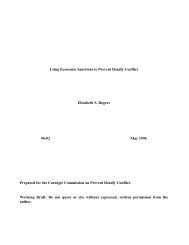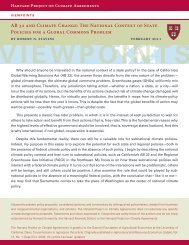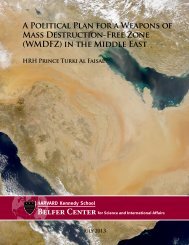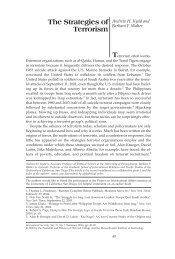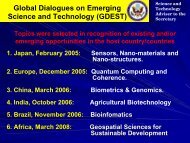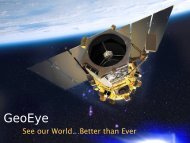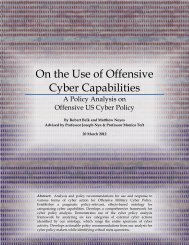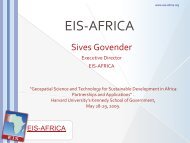Plutonium Mountain - Belfer Center for Science and International ...
Plutonium Mountain - Belfer Center for Science and International ...
Plutonium Mountain - Belfer Center for Science and International ...
- No tags were found...
Create successful ePaper yourself
Turn your PDF publications into a flip-book with our unique Google optimized e-Paper software.
the early 1990s about Semipalatinsk under which Moscow was supposed to supply in<strong>for</strong>mation<br />
about the test site, <strong>and</strong> the Kazakhs agreed to keep some aspects of the site secret. But the Kazakhs<br />
repeatedly complained to Hecker that Russia refused to share details of what had gone on<br />
in those desolate corners of the steppe. The Kazakhs, including Kadyrzhanov, chafed at Russia’s<br />
secrecy. They wanted no part of it, despite the bilateral agreement, which they hoped to change. 39<br />
Hecker wrote down what he saw at Kurchatov City. “Mostly deserted buildings … most of them<br />
had the windows knocked out—a kind of eerie scene out of a ghost-town movie. This was especially<br />
true when I jogged in town early in the morning. The streets were deserted, not a soul. All<br />
I saw was a herd of horses running loose through the outskirts of town <strong>and</strong> an enormous number<br />
of ravens…” 40<br />
The trip to Kazakhstan had been a turning point <strong>for</strong> Hecker.<br />
‘You Left Some Stuff There.’<br />
A few months later, in July, 1998, Hecker headed <strong>for</strong> Moscow. It was a turbulent time in Russia.<br />
Within a month, the country’s fragile economy would collapse with a default <strong>and</strong> devaluation.<br />
From Moscow, Hecker took the overnight train to Sarov, the location of Arzamas-16. Hecker had<br />
developed personal relationships with his counterparts at the laboratory. Although Arzamas-16<br />
was once among the most top-secret facilities in the Soviet Union, <strong>and</strong> was still isolated <strong>and</strong> considered<br />
sensitive, Hecker was known <strong>and</strong> respected by the scientists, <strong>and</strong> his arrival was warmly<br />
welcomed.<br />
He carried an urgent request in his briefcase. He went to see Radi Ilkaev, the director, whom<br />
he had known from earlier projects. Hecker recalled that they met one evening at the House of<br />
Scientists, an in<strong>for</strong>mal setting where they could talk. Hecker brought up the subject of Semipalatinsk<br />
<strong>and</strong> the legacy of testing there, particularly the process of hydronuclear testing. Hecker<br />
mentioned that Los Alamos per<strong>for</strong>med hydronuclear tests in bore holes at Los Alamos in 1960<br />
<strong>and</strong> 1961, <strong>and</strong> left the plutonium in the bore holes, while making sure the areas remained protected.<br />
He added, “You guys must have done something like that at Semipalatinsk. And if you did,<br />
you left some stuff there.”<br />
As Hecker recalled it, Ilkaev responded cautiously, choosing his words. He said Russia was finished<br />
at Semipalatinsk, <strong>for</strong>ever, <strong>and</strong> never wanted to go back. Hecker recalled that when he asked<br />
why, Ilkayev responded by saying the overriding issue at Semipalatinsk was the environment <strong>and</strong><br />
the Russians feared the Kazakhs would insist they clean up all the residue, which would be expensive.<br />
Hecker pulled out the photos he had taken months earlier at Semipalatinsk. He showed<br />
Ilkayev the photograph of the trenches left by the huge earth-cutting machines. “Radi, that’s your<br />
test site. Those are the copper cable thieves,” he recalled saying to Ilkaev. “Radi was just silent.<br />
He just looked at me, <strong>and</strong> looked at the photos. And he said, ‘I’ll have someone to talk to you in<br />
the morning.’” 41<br />
39<br />
Hecker wrote in his notes of the Kazakhs, “They have no desire to keep anything secret.”<br />
40<br />
Hecker, trip report.<br />
41<br />
Interview with Hecker, November 29, 2012, Stan<strong>for</strong>d University.<br />
14<br />
<strong>Plutonium</strong> <strong>Mountain</strong>: Inside the 17-year mission to secure a dangerous legacy of Soviet nuclear testing



